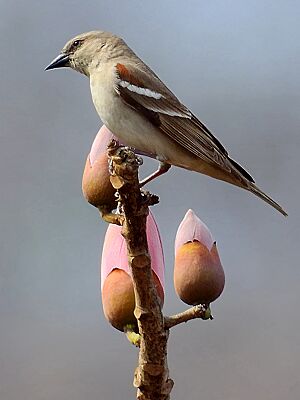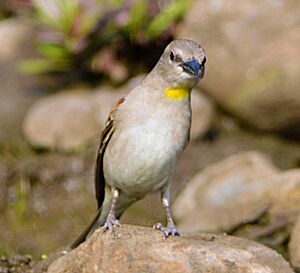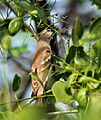Yellow-throated sparrow facts for kids
Quick facts for kids Yellow-throated sparrow |
|
|---|---|
 |
|
| From Mangaon, Raigad, Maharashtra | |
| Conservation status | |
| Scientific classification | |
| Synonyms | |
|
The yellow-throated sparrow is a small bird found across southern Asia. It's also known as the chestnut-shouldered petronia. This bird is a type of Old World sparrow. Its scientific name is Gymnoris xanthocollis.
Contents
What Does It Look Like?
The yellow-throated sparrow is a small bird. It has a thinner beak than other sparrows. Unlike many sparrows, its feathers do not have stripes. A clear sign to spot this bird is the two white bars on its wings. These bars stand out on its dull grey-brown body.
Male and Female Birds
Male yellow-throated sparrows have a chestnut (reddish-brown) patch on their shoulders. This patch can sometimes be hard to see. They also have a light yellow spot on their throat. This spot is brightest when their feathers are new.
Female birds are not as brightly colored. They do not have the chestnut shoulder patch. Their yellow throat spot is much smaller or sometimes missing.
How It Moves and Sounds
This sparrow loves trees. You might also see it on wires or hopping on the ground. Its usual call sounds like a chirrup. However, its song is special and repeats sounds like chilp chalp cholp. When it flies, it moves up and down in a bouncy way.
Where Does It Live?
The chestnut-shouldered petronia lives from Turkey all the way to Iran, Afghanistan, Pakistan, India, and Bangladesh. It has also been seen in Sri Lanka and possibly parts of Myanmar. You can find these birds in forests, gardens, and open areas with bushes.
How It Behaves
Reproduction and Nesting
These sparrows build their nests in tree holes. They breed from April to July. They often use holes made by other birds like barbets and woodpeckers. Sometimes, they even nest in holes found on buildings.
The female bird usually builds the nest. The male might help sometimes. Only the female sits on the eggs to keep them warm. She might leave the nest during the hottest parts of the day. The eggs hatch after about 12 to 14 days.
Daily Life and Food
Yellow-throated sparrows often gather in groups to sleep in low bushes. Some groups of these birds move to different places. They travel when it rains to find better conditions.
They mostly eat grains. But they also enjoy insects, nectar from flowers, and berries. They have been seen eating flower petals, like those from the Madhuca indica tree. When they visit flowers such as Capparis, Salmalia, Erythrina, and Bassia, their foreheads get covered with pollen.
An Inspiring Story
A famous bird expert named Salim Ali (1896–1987) said this sparrow was very important to him. It helped him start his journey into ornithology (the study of birds). When he was a young boy, he shot a sparrow that looked different.
Walter Samuel Millard, who was the secretary of the Bombay Natural History Society (BNHS), helped him identify the bird. Millard also showed Salim Ali the books and bird collections at the museum. Because of this, Salim Ali decided to become a professional ornithologist. In 2003, the BNHS published a book called Petronia to honor him.
Gallery





